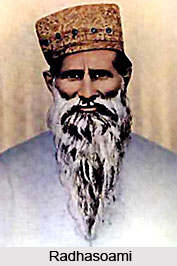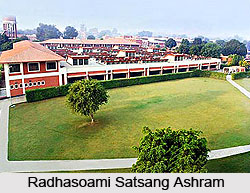 The Radhasoami Satsang is a philosophical organisation, founded by Swami Shiv Dayal, who later became famous as Soamiji Majaraj. The organisation is based on the spiritual teaching of all religions and is devoted to a process of inner growth under the supervision of a spiritual teacher. The organisation teaches an individual path of spiritual development that includes a vegetarian diet, self-restraint from intoxicants, a decent way of life and the observation of daily meditation. No rituals, ceremonies, hierarchies or obligatory contributions are required for the members of the Satsang and there is no compulsory gatherings as well. The members also need not to give up their cultural identity or religious preference to follow this path.
The Radhasoami Satsang is a philosophical organisation, founded by Swami Shiv Dayal, who later became famous as Soamiji Majaraj. The organisation is based on the spiritual teaching of all religions and is devoted to a process of inner growth under the supervision of a spiritual teacher. The organisation teaches an individual path of spiritual development that includes a vegetarian diet, self-restraint from intoxicants, a decent way of life and the observation of daily meditation. No rituals, ceremonies, hierarchies or obligatory contributions are required for the members of the Satsang and there is no compulsory gatherings as well. The members also need not to give up their cultural identity or religious preference to follow this path.
The root of the Radhasoami Satsang lies in the life of Swami Shiv Dayal. And much of the philosophies of Radhasoami Satsang thus echo the philosophy, principle and teachings of Swami Shiv Dayal. He was born in 1818 into a banking family in Agra and belonged to the Khatri caste. The origin of his family was in Punjab and they were Nanakpanthis. His family Guru, Tulsi Sahib recognised the spiritual uniqueness of Shiv Dayal at an early stage and advised him to follow his own preferences that included periods of lengthy meditation. During his adulthood, Swami Shiv Dayal began to draw a circle of disciples and he taught a path of devotion and named it as the Surat Shabad Yoga. Through this path, a person could follow the sound or Shabd that flowed out from the Supreme Being back through various levels of consciousness to its point of origin. A person could also find eternal peace through union with the ultimate, by following the Surat Shabad Yoga. Swami Shiv Dayal made use of the Sikh scriptures, the Guru Granth Sahib and the writings of Tulsi Sahib to preach his ideas.
To reach people and to spread his teachings Swami Shiv Dayal founded the Radhasoami Satsang on request of one of his disciples, named Salig Ram (later known as Huzur Maharaj). The Satsang was established in January, 1861 and its members used to meet daily. They used to read from either the Satsang sacred books or the writings of various north-Indian saints, during the daily meetings. Prayers, hymn-singing and a talk by Shiv Dayal or in his absence, by one of his followers were also the part of the daily meetings. The members worshipped a portrait of Swami during the daily meetings. The members of the Radhasoami Satsang were totally dependent on their teacher for their spiritual upliftment and they spent as much time as possible with him.
According to the Radhasoami Satsang, the whole creation consisted of the three descending spheres, total spirituality being the highest one. The second sphere was a mixture of spiritual-material and the last was a reverse combination of the material-spiritual. The Radhasoamis believed that the Supreme Being dwelt in the first level and the men at the lowest subdivision of the last. The men must find his way up through levels and sublevels to the ultimate spirit that rules over everything else. They also believed that it is the Guru on earth, who has the knowledge and techniques needed for the journey. The ideology of the Radhasoami Satsang was centred on two principles from which a moral code of action was constructed. The first principle was that, `all acts including spiritual practice which tend to free the spirit from matter and raise it towards its sources are good works`, and the second principle is, `all acts which tend to degrade the spirit by weighing it down-wards deeper and deeper into matter are bad works`.
The Radhasoamis were asked to be a lacto vegetarian and were restricted from eating eggs, fish, fowl or meat. They were required to abstain from recreational drugs and alcohol and they believed that the vegetarian diet encourages respect and empathy for all life. According to their beliefs, the vegetarian diet acknowledges that there is a debt to be paid for taking any life. The teachings in the Radha Soami Satsang are also referred as Sant Mat, which means `Teachings of the Saints` (past and present).
 The headquarter of the Radhasoami Satsang was shifted to Soami Bagh in the year 1876, as his disciples built Swami Shiv Dayal a new residence there. Soami Bag also became a place of pilgrimage for the members of the Satsang. After the death of Swami Shiv Dayal, one of his disciples, Sanmukh Das became the leader of the Radhasoami Satsang and the women in the movement were being led by the wife of Swami Dayal, Naraini Devi or Radhaji. However, there were two more strong contenders for leadership of the Satsang, namely Salig Ram and Jaimal Singh.
The headquarter of the Radhasoami Satsang was shifted to Soami Bagh in the year 1876, as his disciples built Swami Shiv Dayal a new residence there. Soami Bag also became a place of pilgrimage for the members of the Satsang. After the death of Swami Shiv Dayal, one of his disciples, Sanmukh Das became the leader of the Radhasoami Satsang and the women in the movement were being led by the wife of Swami Dayal, Naraini Devi or Radhaji. However, there were two more strong contenders for leadership of the Satsang, namely Salig Ram and Jaimal Singh.
Salig Ram brought a sense of organisation and doctrinal development to the Satsang. The ideology of the Satsang was also standardised through a series of publications. He wrote several large and small treatises in Hindi and Urdu to publicise the ideology. His writings gave the members of the movement a more detailed exposition of its ideology and spiritual practices. Salig Ram also managed to unite the leaders together. Salig Ram died in the year 1898.
After Salig Ram`s death, one of his disciples Brahm Shankar Misra became the leader of Radhasoami Satsang. Brahm Shankar was immensely popular among the members of the Satsang and was viewed as the replacement of Salig Ram. Brahm Shankar was known as Maharaj Sahib and he introduced the Central Administrative Council in 1902. The council was introduced to create formal unity among the different branches of the movement. The main objectives of the council were to regulate the conduct of business for the Satsang and its branches; to preserve and administer all properties given to Swami Dayal or acquired by the Satsang; and also to execute any other tasks `in accordance with the directions and mandates of the Sant Sat Guru`. The youngest brother of Swami Shiv Dayal became the first president of the Central Administrative Council and Brahm Shankar Misra and Salig Ram`s son were selected to serve the Council. Brahm Shankar, Salig Ram`s son and Shiv Dayal`s brother had the power of initiating new members into the Satsang and the same power was given to Jaimal Singh and to the leaders of Satsangs in Bengal and Benaras as well. The control and administration of the Radhasoami Satsang were centralised under the Radhasoami Trust, a few years later.
However, the Radhasoami Satsang was divided into three associations in the twentieth century. While two of the associations were active in Agra, the other one operated in Punjab. Among these three, the Radhasoami Satsang Beas rested on the foundation laid by Jaimal Singh and he was succeeded by Baba Sawan Singh Grewal. The teachings of Beas Satsang were based on the belief that Shiv Dayal passed gnostic knowledge to his disciple, Jaimal Singh. Apart from the Beas Satsang, another Satsang was the Ghazipur Satsang, led by Sri Kamta Prasad Sinha (later known as Sarkar Sahib). He declared his Satsang as independent from the Central Administrative Council in March, 1910. The Ghazipur Satsang later became famous as the Dayal Bagh Satsang. The other Radhasoami Satsang was being led by Madhava Prasad (also known as Babuji Maharaj) and was named as the Soamji Bagh Satsang. At present, the Radhasoami Satsang Beas is active in more than 90 countries around the world.
The Radhasoami Satsang was primarily founded to establish the utmost importance of the Guru, as only the Guru can direct the disciples in their quest for the Supreme Being.






































